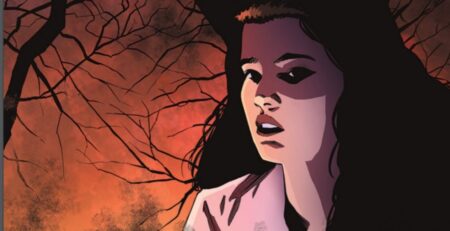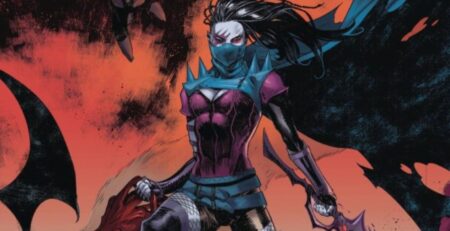
Arsenal: The Game We Love is a sports graphic novel published by Titan Comics. The comic is written and illustrated by Phillipe Glogowski, with colours by Francois Cerminaro. Translated by Emma Wilson. This is officially licensed by Arsenal Football Club, and took over two years to complete.
In 2017, avid Arsenal fan Andrew is trying to make a big impression on his new partner’s son, Nathan. He decides to take him to the Emirates Stadium, where Arsenal is playing against Bournemouth. Trying to gain a connection with the young boy, he attempts to show him the beauty of the game. As the current game plays, he details the history of the club, through its trials and tribulations and the glory days of one of the world’s most iconic sports teams.
There are two aspects to the plot: the biography of Arsenal and the present-day narrative. The two tenses intersect well together, using the football matches to drive the story. The description of the club’s history is well scripted by Glogowski. It doesn’t cover the entire chronology of the team (it’s well over 140 years old), instead starting from the 1996 season. The writer uses the personal perspective of Andrew to depict the “fan” reactions to the victory. Glimpses of the matches and victories are shown, showing the trophy-laden era and introduction of Arsene Wenger, the manager who would lead the team for over two decades.
What would have been appreciated would be more in-depth coverage of the more difficult periods of Arsenal’s journey. It is understandable why the long periods of time without true success are hidden from the reader, as this is licensed by Arsenal themselves. But it may have led to more emotional depth within this graphic novel, so it isn’t just a fluff piece showing how brilliant their brand is. In addition to this aspect, the achievements aren’t given quite the attention that they should. Defining moments of this club’s legacy, Champions League finals and the Invincibles, are shown in single panels.
But there are clever inclusions in regards to selecting which matches are featured as well. These are the seemingly insignificant games of football, such as Arsenal vs. Sheffield Wednesday. But research has been undertaken and there are historically accurate scorelines and lineups mentioned. This adds authenticity to the memories that Andrew comments on, as it may cause them to resurface in the minds of the readers as well. One of the resounding messages of the graphic novel is that each football match is someone’s first, and therefore all are special.
The characters within Arsenal: The Game We Love do possess an identity on occasion. Glogowski funnels most of the character development into Nathan, the child that is taken to the football match. It would have been very easy for the young character to just be on a rollercoaster through time. But his dialogue has weight and meaning, actually leading to some heartwarming moments. This book also uses the characters involved to tap into what is marketed as Arsenal’s values as a club. The North London team has long been associated with the concept of generations, passed down as passion from parent to child. The main plot lacks events to make it interesting, but in this regard, it does succeed.
The art is fascinating, primarily due to how precise the exploration of the club’s history is. Glogowski captures Arsene Wenger’s likeness superbly, as well as the dozens of footballers that have donned that majestic badge. The features of Thierry Henry, Patrick Viera, Ian Wright, and countless others make them instantly recognisable to the football fan. The artist’s lines aren’t perfect, resulting in caricatures, but this style could be seen as more affectionate. Powerful moments within the legacy of football are taken from photos and become line art, resulting in a different interpretation of the event.
Perhaps the most awe-inspiring aspect of the art is within the stadiums. The scale of both Highbury and the Emirates is shown, but there is exquisite attention to detail, as if the aerial and pitchside shots from TV footage have been studied for hours in order to recreate them in a comic panel.
The colours are gorgeous. The kits that the players wear change throughout the years, represented by Andrew’s memories. Despite this, that red remains the same. Ceminaro allies for recognition of the home team and the other teams mentioned by the shades that are on the shirts. The colours are lively and add energy to a comic that is occasionally static and slow.
Arsenal: The Game We Love remembers the glory days but struggles to recapture the passion. The concept is an interesting one, using an original story whilst also retelling twenty years of old ones. Whilst the plot has moments of warmth, it lacks power and real depth. The lack of true balance regarding the history of the club makes the graphic novel too much like a piece of propaganda instead of meaningful literature. However, Glogowski’s commitment to the graphic novel should be appreciated. Two years of work can be seen within the exceptional art, and perhaps that is its most appealing factor.
Arsenal: The Game We Love is available where comics are sold.
Arsenal: The Game We Love
TL;DR
Arsenal: The Game We Love remembers the glory days but struggles to recapture the passion. The concept is an interesting one, using an original story whilst also retelling twenty years of old ones. Whilst the plot has moments of warmth, it lacks power and real depth. The lack of true balance regarding the history of the club makes the graphic novel too much like a piece of propaganda instead of meaningful literature. However, Glogowski’s commitment to the graphic novel should be appreciated. Two years of work can be seen within the exceptional art, and perhaps that is its most appealing factor.






